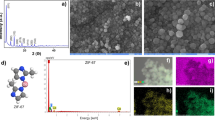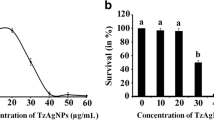Abstract
Due to the emergence of drug resistance, treating Pseudomonas aeruginosa infections is a major health challenge. In a biofilm, bacteria are usually more resistant to antimicrobials than planktonic growth. Thus, antibiofilm compounds can be employed against bacterial infections. In this study, Zinc oxide (ZnO) nanoparticles (NPs) were prepared and functionalized by glutamic acid (ZnO@Glu). Next, the nanoparticles were conjugated with Thiosemicarbazone (ZnO@Glu- TSC), and their antibiofilm activity in combination with Thymol on P. aeruginosa strains was investigated. Physicochemical characterization by FT-IR and XRD analyses showed that the nanoparticles were synthesized properly and their purity was displayed by EDS mapping. The zeta potential of the NPs was − 7.7 mV which indicates the stability of the NPs. Also, the synthesized particles were in the nano-scale size range. Biofilm formation in P. aeruginosa strains was evaluated using Congo-Red agar assay and the antibacterial effect of Thymol and ZnO@Glu-TSC was also studied. Finally, the antibiofilm potential of Thymol, ZnO@Glu-TSC, and Thymol+ZnO@Glu-TSC NPs was studied by crystal violet staining assay. Thymol and ZnO@Glu-TSC NPs had stronger antibacterial potential in combination, and the minimum inhibitory concentration was 3.12–25.5 µg/mL. Also, the combination of the NPs with Thymol led to biofilm inhibition up to 95%, which was significantly higher than either agent alone. This work revealed that Thymol could enhance the antibacterial and antibiofilm potentials of ZnO@Glu-TSC NPs that provides a new option to combat P. aeruginosa infections after further research.







Similar content being viewed by others
References
Zarrini, G.; Delgosha, Z.B.; Moghaddam, K.M., et al.: Post-antibacterial effect of thymol. Pharm. Biol. 48(6), 633–636 (2010). https://doi.org/10.3109/13880200903229098
Najafloo, R.; Behyari, M.; Imani, R., et al.: A mini-review of Thymol incorporated materials: applications in antibacterial wound dressing. J Drug Deliv Sci Technol 60, 101904 (2020). https://doi.org/10.1016/j.jddst.2020.101904
Kazemi-Pasarvi, S.; Ebrahimi, N.G.; Shahrampour, D., et al.: Reducing cytotoxicity of poly (lactic acid)-based/zinc oxide nanocomposites while boosting their antibacterial activities by thymol for biomedical applications. Int. J. Biol. Macromol. 164, 4556–4565 (2020). https://doi.org/10.1016/j.ijbiomac.2020.09.069
Sirelkhatim, A.; Mahmud, S.; Seeni, A., et al.: Review on zinc oxide nanoparticles: antibacterial activity and toxicity mechanism. Nano-micro lett 7(3), 219–242 (2015). https://doi.org/10.1007/s40820-015-0040-x
Shah, A.H.; Manikandan, E.; Ahamed, M.B.; Mir, D.A.; Mir, S.A.: Antibacterial and blue shift investigations in sol–gel synthesized CrxZn1− xO nanostructures. J. Lumin. 145, 944–950 (2014). https://doi.org/10.1016/j.jlumin.2013.09.023
Nejabatdoust, A.; Zamani, H.; Salehzadeh, A.: Functionalization of ZnO nanoparticles by glutamic acid and conjugation with thiosemicarbazide alters expression of efflux pump genes in multiple drug-resistant Staphylococcus aureus strains. Microb. Drug Resist. 25(7), 966–794 (2019). https://doi.org/10.1089/mdr.2018.0304
Clifton, L.A.; Skoda, M.W.; Le Brun, A.P.; Ciesielski, F.; Kuzmenko, I.; Holt, S.A.; Lakey, J.H.: Effect of divalent cation removal on the structure of gram-negative bacterial outer membrane models. Langmuir 31(1), 404–412 (2015). https://doi.org/10.1021/la504407v
Salehi, S.; Mirzaie, A.; Sadat Shandiz, S.A.; Noorbazargan, H.; Rahimi, A.; Yarmohammadi, S.; Ashrafi, F.: Chemical composition, antioxidant, antibacterial and cytotoxic effects of Artemisia marschalliana Sprengel extract. Nat. Prod. Res. 31(4), 469–472 (2017). https://doi.org/10.1080/14786419.2016.1174234
Arvizo, R.R.; Bhattacharyya, S.; Kudgus, R.A.; Giri, K.; Bhattacharya, R.; Mukherjee, P.: Intrinsic therapeutic applications of noble metal nanoparticles: past, present and future. Chem. Soc. Rev. 41(7), 2943–2970 (2012). https://doi.org/10.1039/C2CS15355F
Khalili, H.; Sadat Shandiz, S.A.; Baghbani-Arani, F.: Anticancer properties of phyto-synthesized silver nanoparticles from medicinal plant Artemisia tschernieviana Besser aerial parts extract toward HT29 human colon adenocarcinoma cells. J. Cluster Sci. 28, 1617–1636 (2017). https://doi.org/10.1007/s10876-017-1172-6
Sadat Shandiz, S.A.; Montazeri, A.; Abdolhosseini, M.; Hadad Shahrestani, S.; Hedayati, M.; Moradi-Shoeili, Z.; Salehzadeh, A.: Functionalization of Ag nanoparticles by glutamic acid and conjugation of Ag@ Glu by thiosemicarbazide enhances the apoptosis of human breast cancer MCF-7 cells. J. Cluster Sci. 29, 1107–1114 (2018). https://doi.org/10.1007/s10876-018-1424-0
Abdulhaq, N.; Nawaz, Z.; Zahoor, M.A., et al.: Association of biofilm formation with multi drug resistance in clinical isolates of Pseudomonas aeruginosa. EXCLI J. 19, 201 (2020)
Preda, V.G.; Sãndulescu, O.: Communication is the key: biofilms, quorum sensing, formation and prevention. Discoveries (Craiova) 7(3), e100 (2019)
Kaiser, T.D.L.; Pereira, E.M.; Santos, K.R.N., et al.: Modification of the Congo red agar method to detect biofilm production by Staphylococcus epidermidis. Diag. Microbiol. Infectious Dis. 75, 235–239 (2013)
Freeman, D.J.; Falkiner, F.R.; Keane, C.T.: New method for detecting slime production by coagulase negative staphylococci. J. Clin. Pathol. 42(8), 872–874 (1989)
Moshfegh, A.; Salehzadeh, A.; Sadat Shandiz, S.A.; Shafaghi, M.; Naeemi, A.S.; Salehi, S.: Phytochemical analysis, antioxidant, anticancer and antibacterial properties of the Caspian Sea red macroalgae, Laurencia caspica. Iran. J. Sci. Technol. Trans. A: Sci. 43, 49–56 (2019). https://doi.org/10.1007/s40995-017-0388-5
Coffey, B.M.; Anderson, G.G.: Biofilm formation in the 96-well microtiter plate. In pseudomonas methods and protocols, p. 631–641. Humana Press, New York (2014)
Foo, K.L.; Hashim, U.; Muhammad, K., et al.: Sol–gel synthesized zinc oxide nanorods and their structural and optical investigation for optoelectronic application. Nanoscale Res. Lett. 9(1), 1 (2014). https://doi.org/10.1186/1556-276X-9-429
Khan, M.F.; Ansari, A.H.; Hameedullah, M., et al.: Sol-gel synthesis of thorn-like ZnO nanoparticles endorsing mechanical stirring effect and their antimicrobial activities: potential role as nano-antibiotics. Sci. Rep. 6(1), 1–2 (2016). https://doi.org/10.1038/srep27689
Horcajada, J.P.; Montero, M.; Oliver, A., et al.: Epidemiology and treatment of multidrug-resistant and extensively drug-resistant Pseudomonas aeruginosa infections. Clin. Microbiol. Rev. 32(4), e00031-e119 (2019). https://doi.org/10.1128/cmr.00031-19
Mah, T.F.; Pitts, B.; Pellock, B., et al.: A genetic basis for Pseudomonas aeruginosa biofilm antibiotic resistance. Nature 426(6964), 306–310 (2003). https://doi.org/10.1038/nature02122
Olsen, I.: Biofilm-specific antibiotic tolerance and resistance. Eur. J. Clin. Microbiol. Infect. Dis. 34(5), 877–886 (2015). https://doi.org/10.1007/s10096-015-2323-z
Raei, P.; Pourlak, T.; Memar, M.Y., et al.: Thymol and carvacrol strongly inhibit biofilm formation and growth of carbapenemase-producing Gram negative bacilli. Cell. Mol. Biol. 63(5), 108–112 (2017)
Liu, T.; Kang, J.; Liu, L.: Thymol as a critical component of Thymus vulgaris L. essential oil combats Pseudomonas aeruginosa by intercalating DNA and inactivating biofilm. LWT 136, 110354 (2021). https://doi.org/10.1016/j.lwt.2020.110354
Čabarkapa, I.; Čolović, R.; Đuragić, O., et al.: Anti-biofilm activities of essential oils rich in carvacrol and thymol against Salmonella Enteritidis. Biofouling 35(3), 361–375 (2019)
Miladi, H.; Zmantar, T.; Kouidhi, B., et al.: Synergistic effect of eugenol, carvacrol, thymol, p-cymene and γ-terpinene on inhibition of drug resistance and biofilm formation of oral bacteria. Microb. Pathog. 112, 156–163 (2017). https://doi.org/10.1016/j.micpath.2017.09.057
Mahamuni-Badiger, P.P.; Patil, P.M.; Badiger, M.V., et al.: Biofilm formation to inhibition: Role of zinc oxide-based nanoparticles. Mater. Sci. Eng. C 108, 110319 (2020). https://doi.org/10.1016/j.msec.2019.110319
Abdolhosseini, M.; Zamani, H.; Salehzadeh, A.: Synergistic antimicrobial potential of ciprofloxacin with silver nanoparticles conjugated to thiosemicarbazide against ciprofloxacin resistant Pseudomonas aeruginosa by attenuation of MexA-B efflux pump genes. Biologia 74, 1191–1196 (2019). https://doi.org/10.2478/s11756-019-00269-0
Qayyum, S.; Oves, M.; Khan, A.U.: Obliteration of bacterial growth and biofilm through ROS generation by facilely synthesized green silver nanoparticles. PLoS ONE 12(8), e0181363 (2017). https://doi.org/10.1371/journal.pone.0181363
Author information
Authors and Affiliations
Corresponding author
Rights and permissions
Springer Nature or its licensor (e.g. a society or other partner) holds exclusive rights to this article under a publishing agreement with the author(s) or other rightsholder(s); author self-archiving of the accepted manuscript version of this article is solely governed by the terms of such publishing agreement and applicable law.
About this article
Cite this article
Mokhtari, H., Abdulrazaq Alkinani, T., Ataei-e jaliseh, S. et al. Synergic Antibiofilm Effect of Thymol and Zinc Oxide Nanoparticles Conjugated with Thiosemicarbazone on Pathogenic Pseudomonas aeruginosa Strains. Arab J Sci Eng (2024). https://doi.org/10.1007/s13369-023-08701-z
Received:
Accepted:
Published:
DOI: https://doi.org/10.1007/s13369-023-08701-z




